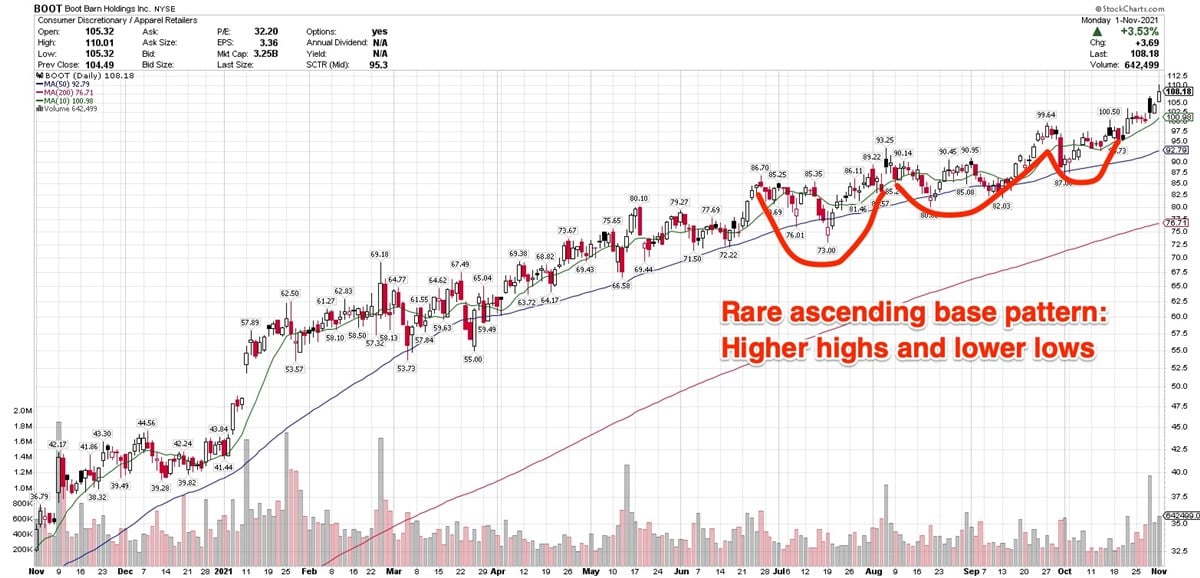Boot Barn Online & In-Store Sales Kick Earnings Higher Western apparel retailer Boot Barn (NYSE: BOOT) kicked up its heels last week, reporting fiscal second-quarter earnings of $1.22 per share, up 510% from the year-ago quarter. Those earnings also...
By Kate Stalter
This story originally appeared on MarketBeat

Western apparel retailer Boot Barn (NYSE: BOOT) kicked up its heels last week, reporting fiscal second-quarter earnings of $1.22 per share, up 510% from the year-ago quarter.
Those earnings also trounced analysts' views of $0.94 per share
Revenue was $312.7 million, ahead of views calling for $289.36 million, according to MarketBeat data. That represented 69% year-over-year revenue growth.
The stock rallied following the report, and reached a new high Monday, closing at $108.18, up $3.69 or 3.53%. Yearly earnings growth accelerated each year since 2018, even managing to grow in fiscal 2021, the year most heavily impacted by pandemic restrictions.
For the full year, Wall Street has pegged earnings growth at 170%, to $5.22 per share.
Rare Chart Pattern
It recently etched a rare pattern, an ascending base, as it rallied along its 10-week moving average.
An ascending base generally occurs when a stock attempts to rally during volatile market conditions, as we've seen in recent months. You'll see a stock with strong fundamentals and institutional support gradually running higher despite challenging market conditions.
The ascending base generally begins after a stock has notched a prior run-up. You're looking for that in any successful base pattern, regardless of its characterization.
An ascending base is made up of three sequential pullbacks. Each pullback has a drawdown somewhere in the vicinity of 10% to 20%, from peak to trough. This is crucial: Each pullback must boast a higher high and a lower low.
The buy point for the recent ascending base was above the high of $99.64, reached on September 27. It cleared that point on October 15, pulled back to test its 10- and 21-day lines, which essentially converged at that point. From there, it rallied to new highs in subsequent sessions.
In last week's report, other highlights included:
- Compared to the quarter ended September 28, 2019, same-store sales increased 53.6%, comprised of an increase in retail store same-store sales of 53.0% and an increase in e-commerce same-store sales of 57.1%.
- The Company opened three new stores and closed one during the 13 weeks ended September 25, 2021.
In the earnings call, president and CEO James Conroy said, "Consistent with our last earnings call and given the impact Covid had on our performance in fiscal 2021, we believe that a comparison of our second-quarter results to the same period two years ago provides the most helpful view into our performance."
In the quarter, he added, the company saw broad-based growth both online and in stores.
Total sales growth on a two-year basis was 67%, with retail stores up 69% and e-commerce up 57%.
New Customers, Not Higher Prices
Conroy elaborated upon those results. "First, a significant portion of the sales increase can be attributed to the addition of new customers added to the Boot Barn brand with only a small portion of the increase attributable to increased retail prices," he said. "Second, we've achieved this growth while dealing with a challenging supply chain where some of our vendors are not shipping us in full."
"Third, the growth is extremely broad-based with nearly every department in the company experiencing strong double-digit growth. And finally, the consistency of the business has been remarkable with 32 consecutive weeks of more than 55% growth in sales on a two-year basis with every one of the 13 weeks in Q2, 60% or better," Conroy said.
Conroy also addressed the company's strategies for dealing with supply-chain issues.
"While we are facing a multitude of challenges, I feel that the company is well-positioned for the upcoming seasonal build in sales. From a supply chain perspective, we are encouraged that our merchants have been able to increase our inventories 34% compared to last year or 9% on a comparable store basis," he said.
Given the technical price action since the earnings report, it appears institutional investors believe there's more upside to come.
MarketBeat data show that more institutional money flowed into the stock than out in the second quarter, a change from the prior two quarters. The number of mutual funds owning shares has grown steadily in the past three quarters, and stood at 454 most recently.











